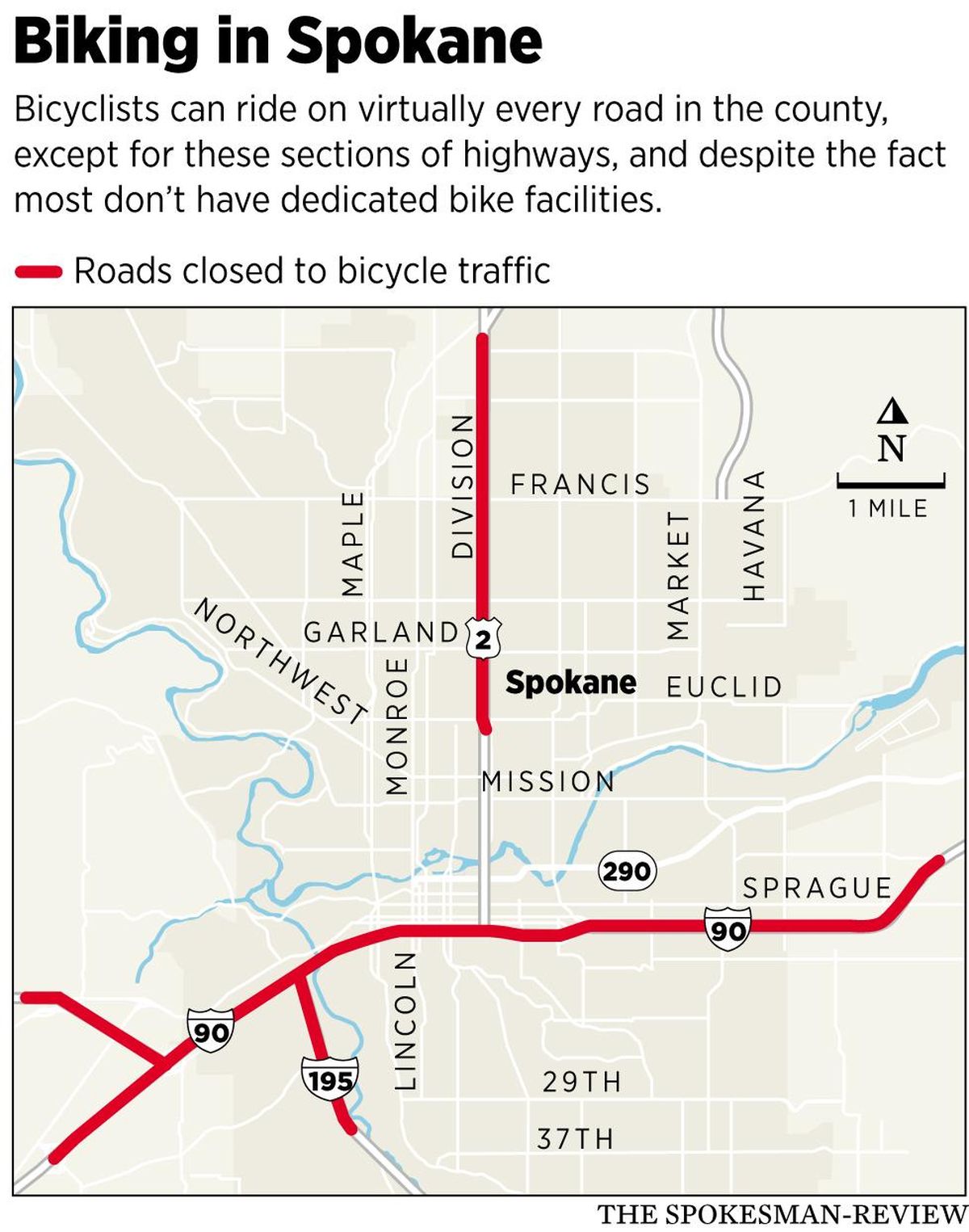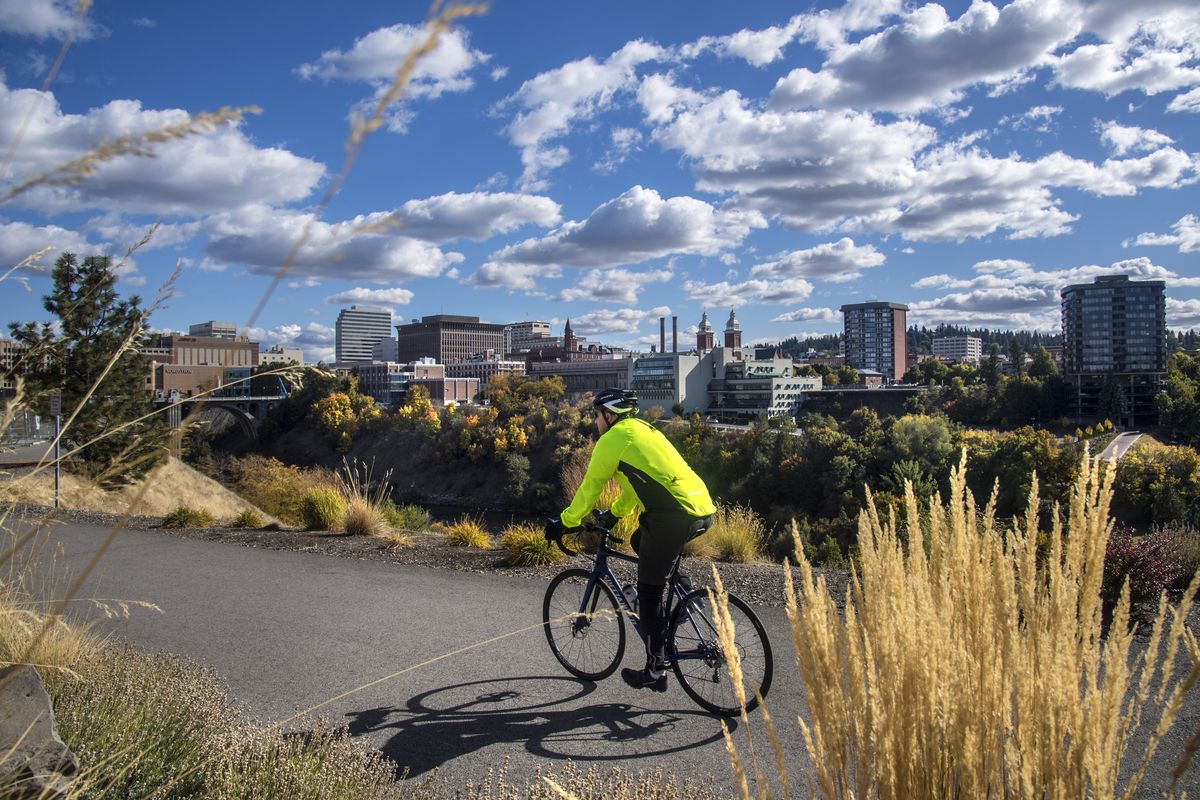Getting there: Cyclists share the road
A few misconceptions about cycling:
Bikes are guests on streets, which are for cars, and they should move out of the way of vehicles.
Cyclists don’t pay gas taxes or vehicle licensing fees, so don’t contribute their fair share to roadwork.
Bicycling is dangerous.
Wrong, three times.
Streets are for everyone, much like a paved national park. By, for and of every user and every mode of travel. Even cyclists.
But many motorists reserve a special sort of indignation for their two-wheeled compatriots.
When on a roadway, a cyclist has all the rights and responsibilities of a motorist. They can ride on virtually every road in Spokane County and take the entire lane if they deem it necessary for their safety. Yes, the entire lane. The whole thing.
Though many drivers misconstrue the primacy of vehicles on the public right of way, cyclists share their rights, and have a few more of their own.
According to state law, two cyclists can ride side by side. Cyclists can choose where they want to ride. On a path, bike lane, shoulder or vehicle lane, wherever they see fit. They are not required to use a bike lane or shoulder.
The law says that cyclists riding below the speed of traffic shall ride as far to the right as is safe. But its up to them to determine what’s safe.
In the state’s eye, a bicyclist is something of a modal changeling. On the road, a bike is a vehicle. But on the sidewalk, a cyclist is a pedestrian. Spokane doesn’t recognize such transfiguration. Riding on the sidewalk downtown is illegal – and unsafe, considering the number of pedestrians.
As for roadwork funding, gas taxes and licensing fees don’t come close to covering the costs for roads. And never have. In 2012, gas taxes and other user fees accounted for 48 percent of what was spent on road building and maintenance. General taxes, primarily property and sales tax in Washington but also federal income tax, accounted for 42 percent.
Like all workers and consumers, cyclists pay sales and income tax. They too contribute to property taxes, either directly as homeowners or indirectly through rent. The street levy approved by Spokane voters in 2014 is generating hundreds of millions of dollars over two decades for maintenance and repair to the city’s arterial roads, and comes exclusively from property taxes.
The idea that roads are only for cars misses the ancient history of roads, and the origin of pavement. Rome’s Appian Way persists to this day, and pavement first came to Spokane in 1893, paid for by the city’s 1889 bicycle tax and used exclusively by wheelmen, as they were called then. The 19th-century path was about five feet wide and ran next to Broadway Avenue just north of the Spokane River. It was graded, graveled, covered with cinder rock and flattened with a 6-ton roller until it was hard as stone. It took four more years for Howard Street to be paved, the first “official” paved road in Spokane.
Around the world, it was bicyclists who first lobbied for flat, hard and well-graded roads – decades before motorists. In 1896, nearly 100,000 cyclists demonstrated in San Francisco is support of the Good Roads movement to repave Market Street.
Despite the long history of seeking safe, quality routes for cyclists, many people still cite safety as the reason they avoid bicycling. But riding a bike is no more dangerous than walking or driving, according to collision data from the National Highway Traffic Safety Administration and Transport Canada.
Still, it could be much safer. As cities like Minneapolis, Portland, New York and Copenhagen show, the more bike infrastructure there is, the more people ride. The more people ride, the safer biking becomes.
The Dutch city, Utrecht, has plowed money into bikeways in recent decades. A new 6,000-space bike parking garage is just the latest, and the city of 330,000 people counts an astounding 125,000 daily bike trips. The city spends an average of $55 million a year on bike infrastructure.
As a New York Times story reported about the city, “Deadly bike accidents have decreased 21 percent over the last two decades, according to state figures. Much of that is attributed to less competition with motor vehicles – the more people ride, the safer it gets.”
By comparison, about 1,700 people in Spokane County said they commuted to work by bike in 2016, about one percent of the population, according to the American Community Survey. The state Department of Transportation reports that two people were hit and killed on their bikes in Spokane County in 2016.
But none of this even gets to the health benefits and reduction in odds to develop heart disease, diabetes, stroke, dementia and some cancers among more active people.
Of course, cyclists are human and not always well-behaved. Late last month, a cyclist allegedly rammed into a walker on the Centennial Trail in Kendall Yards before riding away. He forgot the cardinal rule of the road: pedestrians go first. Yield to them.
Regardless, there’s plenty of room for everyone on the roads. Especially cyclists.
Have a transportation question you want answered? Write nickd@spokesman.com.
State seeks input on transportation plan, impact of climate change
The Washington state Department of Transportation wants feedback on the future of the state’s transportation system and its 20-year transportation plan, which establishes how the state can prepare for an uncertain future in the face of climate change and advances in technology.
The input will guide the second phase of the transportation plan, and will establish how the state can prepare itself for four plausible, but uncertain futures regarding climate change.
The plan builds on its first phase, which established a 20-year vision for the statewide multimodal transportation system.
The Washington State Department of Transportation is seeking public comments on the plan from now through Nov. 6. Read the plan and lodge your comments online at washtransplan.com, or by calling 206-464-1261.
In the city
Starting Monday and ending Friday, Oct. 13, westbound Riverside Avenue between Jefferson and Cedar will be closed to traffic.
Upriver Drive between Mission Avenue and North Center Street will be closed through Oct. 20 due to a construction project being done by Avista.
Minor repair work
Chip-seal work on residential streets will periodically close Arrowhead Drive from Bedford to Shawnee Avenue, and Broad Avenue from Lidgerwood to Nevada Street. They will remain open for local traffic.
Sidewalk repair
Community Development dollars continue to repair sidewalks around town, including 12th Avenue at Adams Street, Ermina Avenue at Addison Street, Cincinnati Street from Gordon Avenue to Glass Avenue, College Avenue at Chestnut Street, and Ninth Avenue at Ivory Street.
In the Valley
Utility work at University and Montgomery to move and replace power poles for re-conductor work will close a vehicle lane between 9 a.m. and 3 p.m. until Oct. 30. A flagger will be on site.
Coeur d’Alene closure
Both directions of Ramsey Road between Interstate 90 and Dalton Avenue in Coeur d’Alene will see intermittent closures through Friday, Oct. 13, for utility work. Drivers should use alternate routes during this time.
The outside southbound lane of Ramsey is scheduled to close from Dalton Avenue to Golf Course Road through Wednesday, Oct. 11, at 5 p.m. The outside northbound lane will close from I-90 to Golf Course Road through Friday, Oct. 13, at 5 p.m.
The construction will take place during daylight hours and includes minor excavation and concrete work. All business and side-street access will be maintained. Minor noise, dust and vibrations can be expected.

